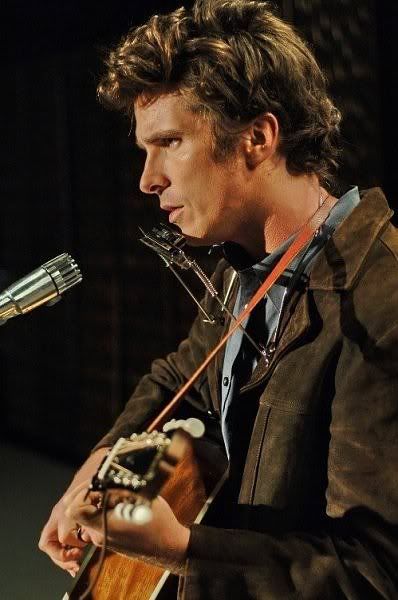
Who are you? What are we? Who or what do we represent? Does it even matter? As filtered through the visionary genius of Todd Haynes, the issue of identity on screen is never perhaps as thoughtful, iconoclastic, and mind-expanding. The housewife, the rock star, and the husband with a secret have all fallen down the rabbit hole in Haynes' work thus far, and returns to that gleaming, sensational, permutable rock star again in his latest topsy turvy amalgamation of ideas, ruminations, and head-scratching antics in "I'm Not There." It's not a complete biography, nor should it be because as the film so effortlessly and deftly conveys, its central subject, the one and only Bob Dylan, is not be classified, caged, or suffocated with traditionalism and laudatory praise. His life is his work but how do we know that? Is that true of all artists and thinkers? Haynes navigates these heady waters and breaks down the image and iconography of Dylan in what is surely one of the most personal and puzzling films of the year.
The Dylan that obsesses, confounds, and enamors Haynes is a mischievous figure without definition and canonization; essentially a poetic punk prophet that somehow unknowingly, or to some very consciously, captured the voice of his generation. This rapturous and rebellious voice obviously speaks with great profundity to Haynes and if his own brief but ever revolutionary body of work would suggest, the spirit of Dylan, in the sense of constantly shape shifting and reaching for something more personal, can be seen in the undefinable and provocative career of Haynes. The tension between folk martyr and resentful artiste seems to fascinate Haynes the most. At once Dylan is a singular and important cultural figure and the next he is a louse of a husband and an elusive and pampered prima donna. This isn't a total representation of Dylan and through the theatrics and masks, that is precisely what Haynes wants us to understand. The film is an alchemic cocktail of studied interpretations and adoring fan suppositions of who and what comprises an essential American idol. Although the film never explicitly communicates Dylan's name, that spirit runs rampant throughout, and the audience should be so glad.
One of the most wisest and inspired choices Haynes employs to pull off his convoluted cinematic circus is the arresting and self-conscious visual appeal. Haynes, cinematographer Edward Lachman, and editor Jay Rabinowitz riff on Fellini, Godard, Altman, Lester, and Pennebaker. In the hands of a less able filmmaker, this could be misconstrued as a pretentious pastiche, but the appropriation of other artists and craftsman has been integral to the success and icon status of Dylan himself. Cate Blanchett as the wiry, androgynous "Blonde on Blonde" era Dylan sits alone on the bathroom floor of some posh hotel swimming in a sea of clippings from Life, Vogue, and Look magazines that act as means of inspiration for Dylan's perception of a society gone wrong in all of its glamor and degradation. Dylan's attraction to the consumption and allure of a spiritually vacant society drowning in its own greed and excess could not be more spot-on for the Fellini parallel Haynes so suitably utilizes in this segment of the film. However, Dylan is just as culpable as the oppressed rock star and paramour of a vapid socialite (a knockout but inconsistent Michelle Williams). Blanchett as Jude is all ticks and Ray-Ban Wayfrarers, but the sight of her attached to a string floating above a circus tent is what lingers the most. It's a wonderful punctuation mark on a performance that is brilliant in its boundless ferocity. Blanchett once again she is a formidable screen presence with her pallid and angular face that is only matched by her piercing and committed eyes. She is Dylan and then some. Blanchett attached to a string and floating like a bizarre balloon above its captive owner is the film boiled down to a moment that is seemingly aloof in what it's trying to say but it's a tripy visual proposition from Haynes that implies Dylan became a product for pure entertainment similar to the way a child derives simple joy from a balloon, although that comfortable entertainment in an industry that is just as hallow as a balloon can ultimately be fleeting. Dylan in his many masks can be loved and adored one moment but repulsive and forgotten in the next. He could easily float away and be lost forever but resonate in the not so distant pop subconscious.
The feeling of being forgotten or the sense of loss gives the film note quite the mythologizing tone a typical biopic would normally and lavishly exploit. Richard Gere as Billy, a wandering sort traipses through the town of Riddle where a decay has set in and nostalgia persists with townspeople wearing masks and Halloween costumes. It's the film's most unusual segment but what it does achieve is a great sense of an elegiac mood that seems to be a death of an overly romanticized era that is out of place with the times. Its pastoral beauty is a twisted and late 70s Fellini-esque homage to the Dust Bowl and outlaw days that inspired Dylan although it is clear that Dylan exists in a mid-20th century world where race riots, wars that go no where, and the youth movement are coalescing into a shocking and uncertain time. A town gathers for a funeral service and Billy watches intently but we're never certain what he feels. He's a passerby unaffected by the sight. The segment is tough to read and could easily be deemed too precocious for its own esoteric implications but it is a joy to watch Haynes audaciously go for it.
"I'm Not There" is most appealing in its daring assuredness. In that respect this could be Haynes' most personal statement yet. This film would not have the same curiosity and beauty if it were made from a lesser Dylan fan. That obsession for a figure so revered and misunderstood is perfectly in line with Haynes' own preoccupation with people who are thinking and feeling on the fringes of normal society. Julianne Moore is deathly allergic to a toxic suburbia in "Safe" and attracted to her gardener not for his skin color but the empathy he shows when it's certain her husband is an outcast in their banal and sexually conservative world in "Far From Heaven." Questioning and pushing sexual boundaries befits the glam rock world of his underrated opus "Velvet Goldmine." The radicalism that exists in those films is expertly written, acted, and aestheticized in "I'm Not There." Charlotte Gainsbourg is a standout as a wife abandoned from her womanizing and chauvinistic movie star husband (a wicked Heath Ledger). She watches the trauma of Vietnam on the television as her marriage crumbles. She questions and recognizes something in that harsh reality as she is sidelined and misapprehended in her tony home she shares with her husband who is occupied with artifice and his own celebrity. Indescribable in her own unique sensuality that is always thrilling to watch, Gainsbourg aches with just the right tone of pain and the acknowledgment of something broken and strange.
Lovers of Dylan and Haynes will find great pleasure in this wild work of art. "I'm Not There" is not as avant-garde and impenetrable as the pre-release buzz would have audiences believe, but it is a ride that is to be taken with Haynes and trust that by the end the experience is what will last and delight. There has not been a film in the past few years that reaches so far and so acutely reminds us that for many art is salvation but it can also be the downfall of those who create it.
Monday, November 26, 2007
what are you?
Posted by
w.
at
11:53 AM
![]()
![]()
Labels: film, todd haynes
Subscribe to:
Post Comments (Atom)



No comments:
Post a Comment